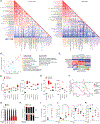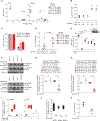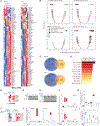The Folate Cycle Enzyme MTHFR Is a Critical Regulator of Cell Response to MYC-Targeting Therapies
- PMID: 32826232
- PMCID: PMC8044910
- DOI: 10.1158/2159-8290.CD-19-0970
The Folate Cycle Enzyme MTHFR Is a Critical Regulator of Cell Response to MYC-Targeting Therapies
Abstract
Deciphering the impact of metabolic intervention on response to anticancer therapy may elucidate a path toward improved clinical responses. Here, we identify amino acid-related pathways connected to the folate cycle whose activation predicts sensitivity to MYC-targeting therapies in acute myeloid leukemia (AML). We establish that folate restriction and deficiency of the rate-limiting folate cycle enzyme MTHFR, which exhibits reduced-function polymorphisms in about 10% of Caucasians, induce resistance to MYC targeting by BET and CDK7 inhibitors in cell lines, primary patient samples, and syngeneic mouse models of AML. Furthermore, this effect is abrogated by supplementation with the MTHFR enzymatic product CH3-THF. Mechanistically, folate cycle disturbance reduces H3K27/K9 histone methylation and activates a SPI1 transcriptional program counteracting the effect of BET inhibition. Our data provide a rationale for screening MTHFR polymorphisms and folate cycle status to nominate patients most likely to benefit from MYC-targeting therapies. SIGNIFICANCE: Although MYC-targeting therapies represent a promising strategy for cancer treatment, evidence of predictors of sensitivity to these agents is limited. We pinpoint that folate cycle disturbance and frequent polymorphisms associated with reduced MTHFR activity promote resistance to BET inhibitors. CH3-THF supplementation thus represents a low-risk intervention to enhance their effects.See related commentary by Marando and Huntly, p. 1791.This article is highlighted in the In This Issue feature, p. 1775.
©2020 American Association for Cancer Research.
Figures





Comment in
-
BETs Need Greens: Folate Deficiency and Resistance to MYC-Targeted Therapies.Cancer Discov. 2020 Dec;10(12):1791-1793. doi: 10.1158/2159-8290.CD-20-1333. Cancer Discov. 2020. PMID: 33262182
Similar articles
-
Meta Analysis of Methylenetetrahydrofolate Reductase (MTHFR) C677T polymorphism and its association with folate and colorectal cancer.BMC Cancer. 2025 Jan 29;25(1):169. doi: 10.1186/s12885-025-13546-w. BMC Cancer. 2025. PMID: 39875876 Free PMC article.
-
Prescription of Controlled Substances: Benefits and Risks.2025 Jul 6. In: StatPearls [Internet]. Treasure Island (FL): StatPearls Publishing; 2025 Jan–. 2025 Jul 6. In: StatPearls [Internet]. Treasure Island (FL): StatPearls Publishing; 2025 Jan–. PMID: 30726003 Free Books & Documents.
-
Folate supplementation in people with sickle cell disease.Cochrane Database Syst Rev. 2018 Mar 16;3(3):CD011130. doi: 10.1002/14651858.CD011130.pub3. Cochrane Database Syst Rev. 2018. PMID: 29546732 Free PMC article.
-
Development of a novel liquid chromatography-tandem mass spectrometry based enzymatic assay of 5,10-methylenetetrahydrofolate reductase.Sci Rep. 2025 Jul 2;15(1):22674. doi: 10.1038/s41598-025-07926-2. Sci Rep. 2025. PMID: 40596302 Free PMC article.
-
Assessing the association between the methylenetetrahydrofolate reductase (MTHFR) 677C>T polymorphism and blood folate concentrations: a systematic review and meta-analysis of trials and observational studies.Am J Clin Nutr. 2015 Jun;101(6):1286-94. doi: 10.3945/ajcn.114.099994. Epub 2015 Mar 18. Am J Clin Nutr. 2015. PMID: 25788000
Cited by
-
Use of recombinant microRNAs as antimetabolites to inhibit human non-small cell lung cancer.Acta Pharm Sin B. 2023 Oct;13(10):4273-4290. doi: 10.1016/j.apsb.2023.07.011. Epub 2023 Jul 15. Acta Pharm Sin B. 2023. PMID: 37799388 Free PMC article.
-
Folate metabolism in myelofibrosis: a missing key?Ann Hematol. 2025 Jan;104(1):35-46. doi: 10.1007/s00277-024-06176-y. Epub 2025 Jan 23. Ann Hematol. 2025. PMID: 39847116 Free PMC article. Review.
-
The Role of Metabolism in the Development of Personalized Therapies in Acute Myeloid Leukemia.Front Oncol. 2021 May 19;11:665291. doi: 10.3389/fonc.2021.665291. eCollection 2021. Front Oncol. 2021. PMID: 34094959 Free PMC article. Review.
-
Lysine catabolism reprograms tumour immunity through histone crotonylation.Nature. 2023 May;617(7962):818-826. doi: 10.1038/s41586-023-06061-0. Epub 2023 May 17. Nature. 2023. PMID: 37198486 Free PMC article.
-
Interplay of YEATS2 and GCDH regulates histone crotonylation and drives EMT in head and neck cancer.Elife. 2025 Aug 14;14:RP103321. doi: 10.7554/eLife.103321. Elife. 2025. PMID: 40810390 Free PMC article.
References
-
- Hanahan D, Weinberg RA. Hallmarks of cancer: the next generation. Cell. 2011;144:646–74. - PubMed
-
- Hsu PP, Sabatini DM. Cancer cell metabolism: Warburg and beyond. Cell. 2008;134:703–7. - PubMed
-
- Lunt SY, Vander Heiden MG. Aerobic glycolysis: meeting the metabolic requirements of cell proliferation. Annual review of cell and developmental biology. 2011;27:441–64. - PubMed
Publication types
MeSH terms
Substances
Grants and funding
LinkOut - more resources
Full Text Sources
Medical
Molecular Biology Databases

